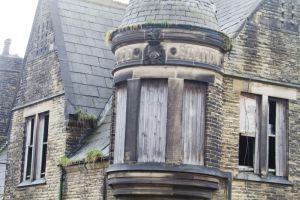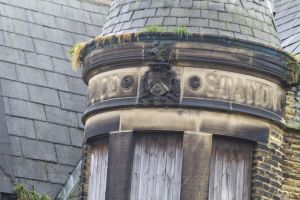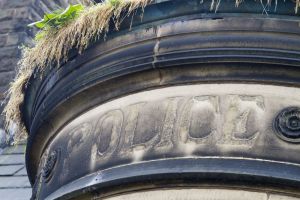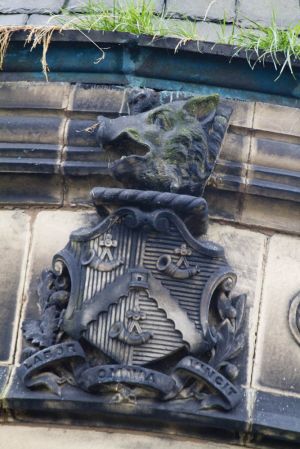Illustrated Weekly Telegraph, Saturday, November 24, 1888
TERRIBLE TRAGEDY AT MANNINGHAM
Double Murder and Suicide
A tragedy of a terrible character was brought to light on Sunday evening at Manningham, the dead bodies of a murdered wife and child and their supposed murderers being discovered in a house in Church Street, where during the day congregations had been peacefully worshipping. The house in which the ghastly discovery was made at No. 35, Church Street, and the family amongst who the terrible tragedy was committed was of the name of Kirkby. The family consisted of James Kirkby, aged 27 years, Alice Kirkby, his wife aged 25 years, Beatrice their eldest daughter, aged 3 years, and an infant son named Tom, aged 11 months. About 8.30 on Sunday morning a neighbour on one side of the house heard the crash of a broken window and a scream, but no notice was taken of the incident, though there is every reason to believe that it was just at this time that the terrible crimes that were subsequently discovered were enacted. During the day the house of the Kirkby’s was locked up, the blinds were down, and no signs of life seemed visible. Even this did not seem to have caused much concern to the neighbours, and it was not until the
CRIES OF A YOUNG CHILD
Were heard about nine o’clock that any one deemed it advisable to enquire what, if anything, had taken place. The mother of Mrs Kirkby, Mrs Waite, resides at 50. Oak Lane, Manningham, and a communication was made to her. She came to the house at 35, Church Street, but found it locked back and front, with the blinds down, and the cries of a frightened child were the only signs of life about the premises. Mrs Waite, in alarm, went to the Manningham Police Station, saw Sub-Inspector Bentley and acquainted him with her fears that something unusual had happened. Bentley at once took with him Police Constable Hardisty and Phillips, and went to Kirkby’s house to make inquiries. No admission could be obtained, and the Sub-Inspector then instructed the constables to go round to the back of the premises and force an entrance. This they did, and Hardisty obtained ingress to the house through the scullery window, which was smashed for the purpose. The little child, Beatrice Kirkby, was found in a dazed and frightened condition alone in the kitchen or “house” in the dark. He proceeded upstairs, and there mad a ghastly discovery. At the top of the open staircase was the dead body of James Kirkby, suspended by a cord from a hook in the ceiling. Lying on the floor near the front bedroom door, clad only in a nightdress, was also the dead body of his wife, Alice Kirkby, with a rope tightly wrapped four or five times around her neck
VICTIM OF A CRUEL AND DELIBERATE MURDER
The infant, Tom Kirkby, also lay on the bed in the same room with a rope around its throat, similarly strangled. The officers cut down the body of James Kirkby, and at once made a report of what they had discovered to Mr Withers, the Chief Constable, the back-door of whose private residence is only a short distance off. He instructed Sub-Inspector Bentley to fetch Mr Mossop, surgeon, which was accordingly done, but the gentleman could do no more than state that death in all three cases occurred several hours previously. Mr Withers at once took charge of the house and made all possible enquiries and arrangements, and finally left the house in charge of police officers for the rest of the night. There is not the slightest reason to doubt that the unfortunate woman and her child were first deliberately murdered by the former’s husband, and that Kirkby after he had done so as deliberately put an end to his own life. Kirkby and his wife had been married for about four years, and for a working man he appears to have had a fairly comfortable home. Formerly he was a driver in the employ of the Bradford Tramway Company, but latterly he has been working at Lister’s Mills as a batter, and is understood to have been in regular employment. The house in which the family resided is one of the old-fashioned cottage class, and stands above the level of the road, with a rockery in front, and overlooks the corner of St Paul’s Church yard on the Church Street side. According to the statements of the neighbours the couple occasionally had quarrels. Kirkby himself, though sometimes fond of a glass, was not a dissolute character, but rather the reverse, whilst his wife is on all hands spoken of as an industrious and well-conducted woman. It is stated, however, that Kirkby was naturally of a jealous disposition, and that the quarrels which they had were due to his mind being
EMBITTERED BY JEALOUS SUSPICIONS
For which there does not appear to have been the slightest foundation. The husband and wife and two children all slept in one bed in the front room facing Church Street, this room like the living apartment downstairs being fairly comfortably furnished, and certainly very tidily kept, thus giving every reason for the belief that Mrs Kirkby was an industrious and attentive wife. What took place between the parties late on Saturday night it is quite impossible to say, for no one appears to have any conception. It is stated there were sounds of a quarrel during the night, but no corroboration of this is forthcoming. It appears pretty certain, however, that about 8 o’clock in the morning of Sunday, Kirkby got out of bed and dressed himself, for when his body was found at night, it was attired in trousers and sleeve vest as though he had been going about the house. All circumstances show, too, that the crimes were committed by him with great deliberation. It is thought by the police that Kirkby got up and left his wife asleep, and it was whilst she was lying asleep that he commenced his horrible task. He appears to have
POSSESSED HIMSELF OF THE CLOTHES LINE
Or rope very much like one, and cut it into three parts. As his wife lay unsuspectingly asleep it is thought that he suddenly put one of the pieces of rope round her neck, and that whilst so engaged she awoke, and a struggle then took place. The bed stands near the window of the room, and about 8.30 on Sunday morning the neighbour on the top side of the house-the house at the bottom side, we should mention, is not tenanted-as already stated, heard some disturbance and the crash of a window pane. This window was found broken when the officers discovered the dead bodies, and it appears probable that it was broken in the struggle. Mrs Kirkby seemed a strong and active woman, and the probability is that if she were not first
ATTACKED IN HER SLEEP
She would either have prevented her husband accomplishing his fell purpose, or would have raised such an alarm as would have roused even the most lethargic of neighbours to action. Mrs Kirkby’s body was found lying face downwards near the door, with the rope wound tightly four or five times round the throat. She has thus either been dragged by her murderer out of bed by the end of the rope, or struggled and fallen in her death agonies on the floor. Her features were horribly blackened as the result of the strangling, and a ghostly stream of blood had flowed from her throat.
The little infant had been dispose of with simply one curl of the rope, and death by strangling was clearly visible in its features, death having apparently taken place whilst the child was crying. How the
LITTLE THREE YEAR OLD DAUGHTER
Of the murderer escaped its fathers clutches it is of course impossible to say, but she was either overlooked or the father suddenly thought he had made enough innocent victims and then proceeded to deliberately hang himself with the third piece of rope which he had left. The dreadful tragedy has caused great consternation in the neighbourhood. The thoroughfare is a busy one on Sundays, and it seems strange to think that numbers of persons passed the house during the day all unconscious of the fact that a young child was alone in the house with three dead bodies. It is also strange that the neighbours should not have thought it necessary to inquire as to the reason for the unusual silence which reigned round the premises. It is currently reported that at the time the window referred to was smashed
A CRY OF “SAVE ME” WAS HEARD,
But the incident of the window smashing and the cry of distress alike seem to have passed unheeded. A high wind was, however, blowing at the time, and it is possible that the breakage may have occurred in the consequence of the storm; whilst it is probable that the neighbours may have readily imagined it to have been so caused.
THE INQUEST
The Borough Coroner (Mr J. G. Hutchinson) opened an inquest at the Town Hall on Monday into the circumstances attending the death of Alice Kirkby, aged 25 years; James Arthur Kirkby, her husband; and Tom Kirkby, aged 11 months, their infant son, of 35, Church Street, Manningham, who were discovered dead at their residence under circumstances reported above. Supt. Campbell was present on behalf of the police. Elizabeth Waite, a widow, of 50, Oak Lane, Manningham, stated that the deceased, Alice Kirkby, was her daughter, and was the wife of James Arthur Kirkby, a machine tenter, employed at Manningam Mills, Mrs Kirkby was 25 years of age. Witness last saw her alive on Thursday night last at 35, Church Street, in company with her husband. The deceased did not make any complaint that night, but in her husband’s presence she had previously
COMPLAINED ABOUT HER HUSBAND’S ILLUSAGE
About three months ago, on a Saturday night, witness called at her daughter’s house, and on that occasion he was calling her either “a pig” or “a liar.” Her daughter complained that night about him abusing her every Saturday night, and that “she did not like to go home at night.” Witness asked him the reason why he went on in that way, but he only replied, “Oh, nothing; she should not talk so much.” She (witness) then “told him a little of her mind,” but he only answered “I wish you would say what you have to say and have done with it.” Her daughter had never complained to her about any violence on the part of her husband, but she had said that he “had done worse.” Witness had since heard, however, that he had
TIED HER DOWN IN BED
Her daughter had two children, one named Beatrice aged two and a half years, another named Tom, aged eleven months. It had been her daughter’s practice to visit her house every Saturday or Sunday, and as she did not come on Sunday witness went to her house about six o’clock, thinking that something was the matter. On arriving there she found the house locked up, and, on looking through the window, she saw the fire was out, and that the clothes horse was standing in the middle of the floor. She thought they must have gone out to pay a visit, and went away. During the evening two other persons with whom Mrs Kirkby worked called upon her and asked about her daughter, but it was not until about ten o’clock that she heard anything which made her suspect anything was wrong. About that time she again went to her daughter’s house, and finding it still closed she called the police, who entered the house by the back window, and then
DISCOVERED THE THREE DEAD BODIES
Her daughter’s husband was not a very sober man, but she did not know that he was violent. They had been married three years. He came from some place wide of York.
Police-constable Hardisty stated that he was acquainted with the deceased. He was on duty on Sunday evening, and about 9.55 from information he entered the house at 35, Church Street, and on getting inside the house he found the dead body of James Arthur Kirkby suspended by a cord at the top of the stairs. On proceeding into the bedroom, and on the floor near the door, he found the dead body of Alice Kirkby. The feet were towards the bed and the head towards the wall. She was lying on her back, and there was a cord tied three times around the neck. There were three separate knots on the cord,, and each round of the cord was tied tightly. The face was discoloured-it was quite black. The body was naked, with the exception of a night gown. There was a little blood about the mouth of the deceased. The ends of the cord appeared to have been cut off near the knot. He was obliged to cut the cord to pieces to get it off. He next looked into the bed, and on turning down the clothes found the dead body of Tom Kirkby, aged eleven months, with his head against the pillow. The body was quite cold, and he observed a mark round the throat such as might have been caused by a nip. The face was a little discoloured. He afterwards cut down the body of the man, which was quite cold. The bed clothes were all disarranged, the bedroom was in disorder, and the carpet looked as though there had been a struggle in the room. He afterwards went down stairs and found Beatrice.
THE OTHER CHILD, PLAYING ON THE HEARTHRUG
She was not injured, and the furniture in this room was in order. He took hold of the child and said, “Beatrice, what are you doing here?” and she replied “Mamma is in bed.” The girl was not dressed, and he gave her to a neighbour. She was almost starved to death. He then examined the two doors of the house, and found they were both fast. Mrs Kirkby had never complained to him about her husband’s treatment. After the discovery, Dr Mossop was sent for and saw the bodies.
Sub-Inspector Bentley, stationed at the Manningham Police Station, was also called and gave similar evidence. He added that there was a piece of rope round the neck of the child found in the bed. The rope was drawn very tight. He had examined all the ropes which had been used, and was of opinion they at one time had all formed one piece. On searching the house he did not find any letters. At this stage the inquiry was adjourned until Wednesday, when
The first witness called was Ellen Bowden, married woman of 37, Church Street, Manningham, who stated she lived next door to the deceased, and she last saw her alive about four o’clock on Saturday last in the afternoon. The deceased’s husband she saw the same day about one o’clock, at which time he went to her for the key. Proceeding witness said that on Sunday morning, about 8.30, she noticed all the blinds in the Kirkby’s house were drawn, butt twenty minutes to nine the downstairs blind had been drawn up, and that one of the four squares of the window upstairs had fallen into the garden below, as if someone had thrust it out. At the same time she also heard the deceased Alice call out “Let me get up; let me get up, will you?” She then went into her own house, and heard the fall of footsteps as of someone going down the stairs of the house in which the deceased resided, and after that heard no more. Witness said she was in her house until the bodies were discovered, but heard nothing throughout the day. She knew the deceased and her husband had lived amicably together, and she had never heard any noise proceed from their house previous to this occasion. P.C. Hardisty, recalled stated that when he went into the room he found the deceased laid on her face, and not on her back, as he previously stated. Her nose had also bent as if it had been crushed.
Dr Mossop, of Manningham, said on Sunday evening about five minutes past ten he saw the dead body of the deceased Alice Kirkby, at which time the body was lying on the floor in the bedroom, and the cord had been removed from the neck. He examined it, and found that the body was that of a well-built and well-nourished female. The surface of the body was pale with the exception of the face and upper portion of the neck. The face was livid, congested and turgid. The tongue protruded from the mouth, and was also livid and swollen. Blood and mucous flowed from the right nostril, and also from the mouth. There were three abrasions on the neck to the right of the wind pipe, each about the size of a sixpence. The neck was also indented as if by pressure from a cord. On the outer surface of the left arm was a distinct bruise appearing to be of recent creation. On the outer side of the right arm were two slight bruises, also an abrasion on the outer side of the right ankle. She was pregnant, in his opinion being some seven months advanced. The pupils of the eyes were dilated.
Coroner: Have you formed any opinion as to about how long the woman had been dead?
Dr. Mossop: The body was perfectly cold, and I think that in all probability death had taken place at least ten hours before I saw her. The cause of death was due to strangulation caused by direct pressure on the windpipe by a cord.
Coroner: It had been stated that the cord was tied three times round the neck. I suppose it would be impossible for a person to tie the rope so many times tight by one’s-self?-Doctor: Yes.
This concluded the evidence, and the Coroner proceeded to address the jury. There could be, said he, little doubt as to the cause of death. They would recollect that it was stated a cord was found tied three times round the deceased’s neck, and so tight that it would be impossible for the deceased woman to do it herself. That therefore did away with the theory of suicide on the part of the woman. Then came the question by whom was the cord tied round her neck and by whom were those injuries inflicted? The evidence showed that there was nobody in the house who could of done it except the children, and they were so young that it would be impossible to suppose for one moment that anyone but the husband had inflicted the injuries. If they then believed that such was the case, the jury would have to return a verdict that the woman had been murdered by her husband – After a few minutes’ consultation the jury returned a verdict of “Wilful murder” against the husband, James Arthur Kirkby.
THE DEATH OF THE BOY
The Coroner then proceeded to review the evidence with regard to the death of the boy Tom, and said that he was found dead in the house at the same time as his mother on Sunday night last, under the clothes of one of one of those beds. One of the witnesses called also stated that he noticed marks around the neck, and the rope taken from the lad’s neck was of the same sort as that cut from the neck of the mother. There could be no doubt that the cause of the death off the child was strangulation. Then came the question, who inflicted the injuries? There was no one in the house who could of caused them except the father or the mother, and if they believed the evidence and took into consideration the verdict returned in the last case they must come to the conclusion that the boy had been murdered by his father. In this case also the jury returned a verdict of “Wilful murder” against the father.
THE DEATH OF THE MURDERER
Verdict of Felo de se
Mr Hutchinson, referring to the death of the man James Arthur Kirkby, the husband of Alice and father of the boy Tom, said the jury would have to inquire by what means he had come to his death. At the same time as the other two he was discovered dead in the house at Church Street, suspended by the neck with a cord attached to a hook at the top of the stairs. There could be little doubt as to the immediate cause of death in this case, it being due to strangulation. There was no one in the house who could be responsible for his death but himself, and the jury would have no difficulty in coming to the conclusion that the man had hung himself, and if they were satisfied on that point they would then have to consider the state of his mind. The Coroner said he must impress upon the jury the fact that the law considered all persons as sane and responsible for their acts until evidence was called sufficient to prove the contrary. In this case the evidence went to show that the man’s mind was not affected. He apparently indulged in bad language, but that was not sufficient ground to justify the jury in coming to the conclusion that his mind was affected. They would have to consider the surroundings of the case. The Coroner then proceeded to review the evidence the evidence as it more particularly concerned the actions of the husband, and pointed out that the condition in which the woman was found demonstrated that the man must have been most determined in his intention. The woman called out, and the breaking off the window went to show how fixed was his determination as to what was to be done with his wife. He tied the rope once, tied it a second time, and then a third time, tightly on all three occasions, in so much that once, if only the knot had held fast, would have been sufficient to destroy life. Then again the child was on the bed, and they had heard it stated that the rope was tied tightly around his neck. This, along with the other facts, went to show that the man knew what he was doing, and had a firm intention which he was determined to carry out with determination. The marks on the woman’s body also went to show that a severe struggle had taken place, and there was no evidence, save the mad act itself, to show that the man’s mind was at all affected. If the committing of such an act, however, were sufficient to render people liable to be considered in a state of temporary insanity life would never be taken by any sane person. It was a matter entirely for the jury to decide as to what was the condition of the man’s mind, but in the absence of any evidence showing that Kirkby’s mind was temporarily affected the proper verdict to return would be of felo de se – The jury retired, and as they were doing so the Coroner said: – You will bear in mind there is no evidence before you that the man’s mind has been affected before, or anything of the kind.
The jury were absent about three quarters of an hour, during which time they requested and received the assistance of the Coroner twice or thrice on some point.
On returning into the Court the Coroner asked “Are you agreed upon a verdict, Mr Foreman?”
Foreman: “Yes”
“And what is the verdict?”
Foreman: “Felo de se.”
“FELO DE SE”
“Felo de se” has come to be regarded as an anti-quated verdict, having long ago been superseded for the more modern and fashionable one of “temporary insanity.” It’s really surprising when one thinks of it, how some men labour with the greatest assidity and pertinacity to prove either their own or someone else’s insanity. But the Bradford Coroner appeared to be quite convinced there was no hope for Kirkby, the Manningham murderer, and took good care to convey his opinion in plain words to the jury, with the result that for once in a way a person who took the life of another was found to have been in his right mind.
In these days, however, the verdict has not attached to it all the degrading formalities of a past age. There’s no taking the body to the centre of some cross roads, sticking it through with a stake &c., &c., The poor fellow will merely be deprived of the services of a minister of the Established Church, and unless some friend chooses to read a service, as I hear will be the case, the funeral will have to take place without any such ceremony.
, Saturday, December 1, 1888 sm.jpg)












